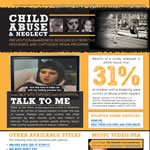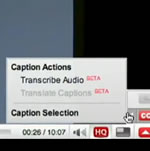

 |
 |
 |
 |
 |
 |
In this issue: |
HOLIDAYS | CA/N | GOOGLE LAUNCH |
skip to quick hits
Winter Holiday Media from the DCMPBack to article listing
Amidst all of the celebrating and observing that goes on in the waning weeks before winter break, there are many wonderful opportunities for learning. That’s why the DCMP invites you to try out some of our holiday-themed media [PDF] with your students this month. Your students can learn about the significance of the seven candles on a kinara (preview Seven Candles for Kwanzaa), the true meaning of Hanukkah (preview In the Month of Kislev), the Lunar New Year custom of lucky money (preview Sam and the Lucky Money), and the delicious food that has become a part of the various celebrations, all while getting a refresher on the names of Santa’s eight reindeer from a classic Christmas poem. And that’s just for starters! If you’re looking for a change of pace this year, why not introduce your students to some of the more unconventional December holidays [PDF]? Spanning a broad range of topics from aviation to volunteering, there is a wealth of learning potential in the lesser-known holidays, and the DCMP is ready to help out by providing top-quality media content—always at no charge to our registered members! Recognize and Prevent Child Abuse and NeglectBack to article listing
Though this time of year is traditionally filled with a sweeping sense of goodwill and hopefulness, for millions of children, the looming (and all too real) specter of child abuse and neglect (CA/N) makes the holiday season a far cry from “the most wonderful time of the year.” The DCMP has teamed with the CA/N prevention organization Childhelp to create a captioned and a described version of Collin Raye’s “The Eleventh Commandment” music video/PSA. For the first time ever, this emotionally striking production is fully accessible to all viewers. CA/N prevention is an important issue for us here at the DCMP, given our mission to serve children with hearing or vision loss. Did you know that the results of a 2000 study found that 31% of children with one or more disabilities had suffered some degree of CA/N, or that children with disabilities are 3.4 times more likely to be victimized than their peers who don’t have disabilities? We’ve built a collection of CA/N-related titles [PDF] that we invite you to explore to learn more about this pressing societal problem. We also have written an article about child abuse and children who are deaf [PDF] as well as an article about preventing abuse of teens [PDF]. For a wealth of information about preventing abuse of children who are deaf or hard of hearing, visit the Deaf Education Community of Learners Concerning Child Abuse & Neglect wiki, provided by deafed.net. About ChildhelpThe Childhelp National Child Abuse Hotline, 1-800-4-A-CHILD, operates 24 hours a day, seven days a week, and receives calls from throughout the United States, Canada, the U.S. Virgin Islands, Puerto Rico, and Guam. Childhelp’s programs and services also include residential treatment services; children’s advocacy centers; therapeutic foster care; group homes and child abuse prevention, education, and training. Childhelp also created the Childhelp National Day of Hope, held each April during National Child Abuse Prevention Month, that mobilizes people across America to join the fight against child abuse. Google Makes Strides Toward Increased YouTube AccessibilityBack to article listing
Last month, a representative from the DCMP was on hand in Washington, D.C. as developer Ken Harrenstien and other Google developers announced the impending availability of new automated accessibility features for YouTube. For anyone who hasn’t yet learned, YouTube videos will soon feature an option by which machine-generated captions (based upon the Google Voice text-to-speech engine) may be enabled for any YouTube video by the end user. Obviously, machine-generated captions are not as accurate as human-generated captions—nor do they contain important elements like speaker identification or a description of sound effects—but this announcement is definitely a step in the right direction for improved access for the millions of Americans who depend on captioning to access information. (Watch a demonstration of the new auto-captioning feature, as well as a discussion about some of its limitations.) What caught our attention more than the auto-captioning feature was the subsequent announcement of YouTube’s new “auto-synchronization” (auto-sync) tool. As “captioning evangelist” Naomi Bilodeau explains during her demonstration, the auto-sync feature will allow a user to upload a transcription of his/her video’s spoken content, and YouTube will automatically generate a timed caption file, which can then be downloaded and edited (to add other vital, non-speech information). This feature should be available on all new uploads to YouTube and will definitely be a boon to those who are interested in Captioning It Yourself. By the way, did you know why captions are useful to YouTube channel owners for reasons other than accessibility? Watch Naomi Bilodeau explain how captions can improve your YouTube channel’s exposure in searches. The DCMP applauds Google for continuing its work to make the internet a more friendly and accessible place for all people! |
Subscribe to the NewsletterSubscribe to the DCMP newsletter.
Free Assistive-Technology Resources from NCTI & CITEdThe Center for Implementing Technology in Education (CITEd) and the National Center for Technology Innovation (NCTI) have created a number of helpful resources (for parents, educators, administrators, and students making assistive-technology [AT] decisions), such as the TechMatrix, a free online database that presents hardware and software reviews and research based on technology features and can assist you in your AT decision-making. NCTI and CITEd have also partnered with WETA Online media to create information briefs on a variety of topics related to AT use for children and teens. Whether you’re looking for guidance on AT at work, at home, after school, or for students heading off to college, these info briefs can help you become a more informed and empowered consumer. 

Focus on: BlindskillsContributed by Vicky Young, a retired teacher of students with visual impairments who currently holds board positions at Blindskills and the Hadley School for the Blind. Blindskills was established in 1983 to make a difference in the lives of blind K–12 students and has continued to focus and build upon its mission to share resources and information with blind or visually impaired people and their families, mainly through the publication of DIALOGUE magazine. Blindskills strives to provide the most needed pieces of information—support, empathy, and specialized knowledge—customized for people with vision loss of many different ages and circumstances. 
|
 |
|
|
The Described and Captioned Media Program is funded by the U.S. Department of Education and administered by the National Association of the Deaf. |
Visit the DCMP Website |
The contents of this newsletter were developed under a grant from the U.S. Department of Education, Cooperative Agreement #H327N060002. However, those contents do not necessarily represent the policy of the U.S. Department of Education, and you should not assume endorsement by the Federal Government. Project Officer, Ernest Hairston.





